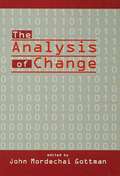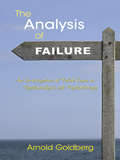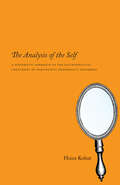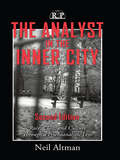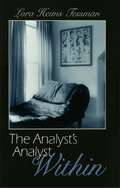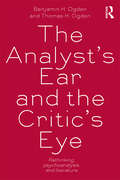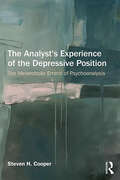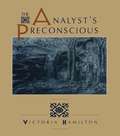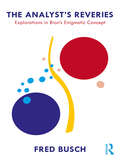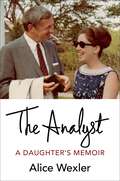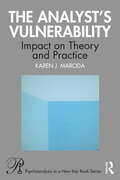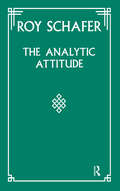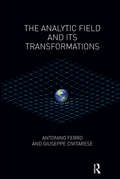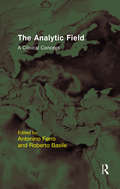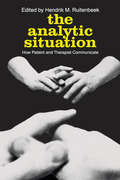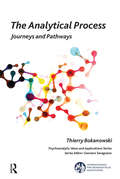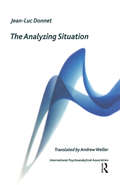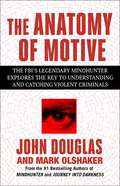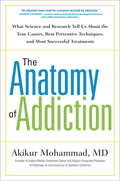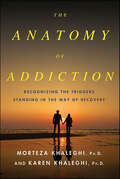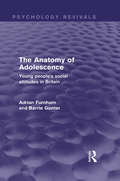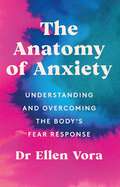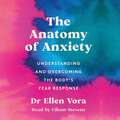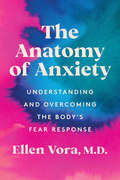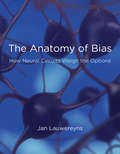- Table View
- List View
The Analysis of Change
by John Mordechai GottmanContinuity and change have been major concerns of the social and behavioral sciences -- in the study of human development and in the study of processes that unfold in various ways across time. There has been a veritable explosion of techniques for studying change over time which have fundamentally changed how we need to think of and study change. Unfortunately, many of the old precepts and beliefs are still among us. The field of methodology for the study of change is itself ready to change. Recently, there have been many analytic and conceptual developments questioning our cherished beliefs about the study of change. As such, how are individuals to think about issues and correctly analyze change? The chapters in this volume address these issues. Divided into two sections, this book deals with designs that analyze change in multiple subjects, and with change in single subjects and an interacting system. Papers presented in this volume are accessible to scientists who are not methodologists. The character of the papers are more like primers than basic treatises on methodology, written for other methodologists. It is time that people stop thinking in rigid ways about how to study change and be introduced to a range of many possibilities. Change, stability, order and chaos are elusive concepts. The pursuit of the laws of change must be approached in as flexible and creative a fashion as possible. This book should help to lead the way.
The Analysis of Failure: An Investigation of Failed Cases in Psychoanalysis and Psychotherapy
by Arnold GoldbergPsychotherapy and psychoanalysis don't always work. Inevitably, a therapy or analysis may fail to alleviate the suffering of the patient. The reasons why this occurs are as manifold as the patients and analysts themselves, and oftentimes are a source of frustration and vexation to clinicians, who aren't always eager to discuss them. Taking the challenge head-on, Arnold Goldberg proposes to demystify failure in an effort to determine its essential meaning before determining its causes. Utilizing multiple vignettes of failed cases, he offers a deconstruction and a subsequent taxonomy of failure, delineating cases that go bad after six months from cases that never get off the ground, mismatches from impasses, failures of empathy from failures of inattention. Commonalities in the experience of failure – conceived as less a misapplication of technique than consequences of a co-constructed yet fraught therapeutic relationship – begin to emerge for scrutiny.
The Analysis of the Self: A Systematic Approach to the Psychoanalytic Treatment of Narcissistic Personality Disorders
by Heinz KohutPsychoanalyst, teacher, and scholar, Heinz Kohut was one of the twentieth century's most important intellectuals. A rebel according to many mainstream psychoanalysts, Kohut challenged Freudian orthodoxy and the medical control of psychoanalysis in America. In his highly influential book The Analysis of the Self, Kohut established the industry standard of the treatment of personality disorders for a generation of analysts. This volume, best known for its groundbreaking analysis of narcissism, is essential reading for scholars and practitioners seeking to understand human personality in its many incarnations. “Kohut has done for narcissism what the novelist Charles Dickens did for poverty in the nineteenth century. Everyone always knew that both existed and were a problem. . . . The undoubted originality is to have put it together in a form which carries appeal to action.”—International Journal of Psychoanalysis
The Analyst in the Inner City, Second Edition: Race, Class, and Culture Through a Psychoanalytic Lens (Relational Perspectives Book Series)
by Neil AltmanIn 1995, Neil Altman did what few psychoanalysts did or even dared to do: He brought the theory and practice of psychoanalysis out of the cozy confines of the consulting room and into the realms of the marginalized, to the very individuals whom this theory and practice often overlooked. In doing so, he brought together psychoanalytic and social theory, and examined how divisions of race, class and culture reflect and influence splits in the developing self, more often than not leading to a negative self image of the "other" in an increasingly polarized society.<P><P> Much like the original, this second edition of The Analyst in the Inner City opens up with updated, detailed clinical vignettes and case presentations, which illustrate the challenges of working within this clinical milieu. Altman greatly expands his section on race, both in the psychoanalytic and the larger social world, including a focus on "whiteness" which, he argues, is socially constructed in relation to "blackness." However, he admits the inadequacy of such categorizations and proffers a more fluid view of the structure of race. A brand new section, "Thinking Systemically and Psychoanalytically at the Same Time," examines the impact of the socio-political context in which psychotherapy takes place, whether local or global, on the clinical work itself and the socio-economic categories of its patients, and vice-versa. Topics in this section include the APA’s relationship to CIA interrogation practices, group dynamics in child and adolescent psychotherapeutic interventions, and psychoanalytic views on suicide bombing.<P> Ranging from the day-to-day work in a public clinic in the South Bronx to considerations of global events far outside the clinic’s doors (but closer than one might think), this book is a timely revision of a groundbreaking work in psychoanalytic literature, expanding the import of psychoanalysis from the centers of analytical thought to the margins of clinical need.
The Analyst's Analyst Within
by Lora H. TessmanThe Analyst's Analyst Within is the most illuminating study to date of how psychoanalysts' experiences with their own analysts affect their lives, their loves, and their evolving professional identities. A gifted interviewer with equally gifted interview subjects, Tessman samples different gender combinations and age ranges in showing how the values typifying different eras of psychoanalytic theorizing enter into the meaning and impact of training analyses. Tessman's findings are striking, and they do not end with her discovery of startling differences according to the decade during which a training analysis took place. She also found that neither the theoretical orientation of the training analyst nor his or her technical preferences predicted whether, years later, the analysis would be remembered as satisfying or dissatisfying, as growth promoting or thwarting. Rather, it was the quality of affective engagement that became reliably present, with the figure of the training analyst, inscribed in all his or her particularity, accounting for the perceived sense of a truly productive analytic experience. Tessman's research program, which encompasses her methodology, her skill as an interviewer, and the wisdom and clarity of thought of her participants, lifts this work well beyond the perfunctory debates about psychoanalytic training that recur in the journal literature. The power of The Analyst's Analyst Within resides in compelling individual narratives in which analysts revisit their own treatment past - and the analyst within - with candor, vividness, and often great poignancy. The result is a book that not only supersedes previous studies of the training analysis but also opens a new vista on how and why analysis works when it works and fails when it fails.
The Analyst's Ear and the Critic's Eye: Rethinking psychoanalysis and literature
by Thomas H. Ogden Benjamin H. OgdenThe Analyst‘s Ear and the Critic‘s Eye is the first volume of literary criticism to be co-authored by a practicing psychoanalyst and a literary critic. The result of this unique collaboration is a lively conversation that not only demonstrates what is most fundamental to each discipline, but creates a joint perspective on reading literature that ne
The Analyst's Experience of the Depressive Position: The melancholic errand of psychoanalysis
by Steven H. CooperIn The Analyst’s Experience of the Depressive Position: The Melancholic Errand of Psychoanalysis, Steven Cooper explores a subject matter previously applied more exclusively to patients, but rarely to psychoanalysts. Cooper probes the analyst’s experience of the depressive position in the analytic situation. These experiences include the pleasures and warmth of helping patients to bear what appears unbearable, as well as the poignant experiences of limitation, incompleteness, repetition and disappointment as a vital part of clinical work. He describes a seam in clinical work in which the analyst is always trying to find and re-find a position from which he can help patients to work with these experiences. The Analyst’s Experience of the Depressive Position includes an exploration of the analyst’s participation and resistance to helping patients hold some of the most unsettling parts of their experience. Cooper draws some analogies between elements of theory about aesthetic experience in terms of how we bear new and old experience. He provides an examination of the patient as an artist of sorts and the analyst as a form of psychic boundary artist. Just as the creative act of art involves the capacity to transform pain and ruin into the depressive position, so does the co-creation of how we understand the patient’s mind through the mind of the analyst. The Analyst’s Experience of the Depressive Position explores a rich, provocative and long overdue topic relevant to psychoanalysts, psycho-dynamically oriented psychotherapists, as well as students and teachers of both psychoanalysis and psychodynamic psychotherapy.
The Analyst's Preconscious
by Victoria HamiltonHow do the analyst's consciously held theoretical commitments intersect with the actual conduct of analysis? Do commitments to notions like "psychic truth" or "analytic neutrality" affect interpretive style, the willingness to acknowledge treatment mistakes, and other pragmatic preferences? Does the commitment to cerain comcepts entail commitment to related ideas and practices to the exclusion of others? This is the uncharted domain that Victoria Hamilton explores in The Analyst's Preconscious. At the heart of her endeavor is an imaginatively conceived empirical investigation revolving around in-depth interviews with 65 leading analysts in the United States and Britain. In these lively and free-ranging discussions, the reader encounter firsthand the thoughtfulness with which practitioners wrestle with the ambiguous relations between various theoretical positions, whether or not their own, and the exigencies of the therapeutic encounter. The result is a uniquely detailed map of contemporary psychoanalysis. Hamilton documents the existence of different analytic cultures, each shaped by a need to maintain inner consistency among fundamental assumptions and also by extratheoretical factors, including geography, collegial experiences, and exposure to particular teachers and supervisors. A major contribution to understanding the pluralism of contemporary psychoanalysis, The Analyst's Preconscious is also a celebration of the dedication and sensitivity with which contemporary analysts seek to organize their therapeutic practices amidst the welter of proliferating concepts and rival schools of thought. Coming at a critical juncture in the history of the field, this work is indispensable to all who care about psychoanalytic culture and psychoanalytic practice, and especially about the analyst's real-world adaptation to the theoretical turbulence of our time.
The Analyst's Reveries: Explorations in Bion's Enigmatic Concept
by Fred BuschWhile the use of the analyst’s own reveries in work with patients has increased in recent times, there has been little critical inquiry into its value, and the problems it may lead to. The Analyst's Reveries finds increasing veneration for the analyst’s use of their reveries, while revealing important differences amongst post-Bionians in how reverie is defined and used clinically. Fred Busch ponders if it has been fully recognized that some post-Bionions suggest a new, radical paradigm for what is curative in psychoanalysis. After searching for the roots of the analyst’s use of reverie in Bion’s work and questioning whether in this regard Bion was a Bionian, Busch carefully examines the work of some post-Bionians and finds both convincing ways to think about the usefulness and limitations of the analyst’s use of reverie. He explores questions including: From what part of the mind does a reverie emerge? How does its provenance inform its transformative possibilities? Do we over-generalize in conceptualizing what is unrepresented, with the corresponding problem of false positives? Do dreams equal understanding and what about the generalizability of the co-created reverie? Busch concludes that it is primarily through the analyst’s own associations that the reverie’s potential is revealed, which further helps the analyst distinguish it from many other possibilities, including the analyst’s countertransference. He believes in the importance of converting reveries into verbal interpretations, a controversial point amongst post-Bionians. Busch ends with the difficult task of classifying the analyst’s reveries based on their degree of representation. The Analyst's Reveries will be of great interest to psychoanalysts and psychoanalytic psychotherapists.
The Analyst: A Daughter's Memoir
by Alice WexlerMilton Wexler was among the most unconventional, compelling, and sometimes controversial figures of the golden age of psychoanalysis in America. From Teachers College at Columbia University to the Menninger Foundation in Topeka to the galleries and gilded hills of Hollywood, he traversed the country and the century, pursuing interests ranging from the treatment of schizophrenia to group therapy with artists to advocacy for research on Huntington’s disease. At a time when psychologists and psychoanalysts tended to promote adjustment to society, Wexler increasingly championed creativity and struggle.The Analyst is an intimate and searching portrait of Milton Wexler, written by his daughter, an acclaimed historian. Alice Wexler illuminates her father’s intense private life and explores how his life and work reveal the broader reaches of Freudian ideas in the United States. She draws on decades of Milton Wexler’s unpublished family and professional correspondence and manuscripts as well as her own interviews, diaries, and memories. Through the lens of Milton Wexler’s friendships, the book offers glimpses into the lives of cultural icons such as Lillian Hellman, Eppie Lederer (Ann Landers), and Frank Gehry. The Analyst is at once a striking account of the arc of an iconoclast’s life, a daughter’s moving meditation on her complex father, and a new window onto on the wider landscape of psychoanalysis and science in the twentieth century.
The Analyst’s Vulnerability: Impact on Theory and Practice (Psychoanalysis in a New Key Book Series)
by Karen J. MarodaThis book closely examines the analyst’s early experiences and character traits, demonstrating the impact they have on theory building and technique. Arguing that choice of theory and interventions are unconsciously shaped by clinicians’ early experiences, this book argues for greater self-awareness, self-acceptance, and open dialogue as a corrective. Linking the analyst’s early childhood experiences to ongoing vulnerabilities reflected in theory and practice, this book favors an approach that focuses on feedback and confrontation, as well as empathic understanding and acceptance. Essential to this task, and a thesis that runs through the book, are analysts’ motivations for doing treatment and the gratifications they naturally seek. Maroda asserts that an enduring blind spot arises from clinicians’ ongoing need to deny what they are personally seeking from the analytic process, including the need to rescue and be rescued. She equally seeks to remove the guilt and shame associated with these motivations, encouraging clinicians to embrace both their own humanity and their patients’, rather than seeking to transcend them. Providing a new perspective on how analysts work, this book explores the topics of enactment, mirror neurons, and therapeutic action through the lens of the analyst’s early experiences and resulting personality structure. Maroda confronts the analyst’s tendencies to favor harmony over conflict, passivity over active interventions, and viewing the patient as an infant rather than an adult. Exploring heretofore unexamined issues of the psychology of the analyst or therapist offers the opportunity to generate new theoretical and technical perspectives. As such, this book will be invaluable to experienced psychodynamic therapists and students and trainees alike, as well as teachers of theory and practice.
The Analytic Attitude
by Roy SchaferThe analytic attitude" ranks as one of Freud's greatest creations. Both the findings of psychoanalysis as a method of investigation and its results as a method of treatment depend on its being consistent to a high degree. Yet Freud offered no concise, complex, generally acceptable formulation of what it is: his ideas, or a version of them, can only be derived from his papers on technique. Taking these ideas as a starting point, and with due regard to the contributions of other analysts over the years, the author rises to the challenge of defining the "ideal" attitude that he come to aspire to in his work as an analyst. To this end the author discusses not only the analyst's empathy, the need to establish an "atmosphere of safety" in relation to the dangers the patient perceives when facing the possibility of insight and personal change, but also the concepts of transference and resistance, and the nature of psychoanalytic interpretation and reconstruction.
The Analytic Field and its Transformations
by Giuseppe CivitareseThe Analytic Field and its Transformations presents a collection of articles, written jointly by the authors in recent years, all revolving around the post-Bionian model of the analytic field - Bionian Field Theory (BFT). Going hand-in-hand with the ever-growing interest in Bion in general, analytic field theory is emerging as a new paradigm in psychoanalysis. Bion mounted a systematic deconstruction of the principles of classical psychoanalysis. His aim, however, was not to destroy it, but rather to bring out its untapped potential and to develop ideas that have remained on its margins. BFT is a field of inquiry that refuses a priori, at least from its own specific perspective, to immobilize the facts of the analysis within a rigid historical or intrapsychic framework. Its intention is rather to bring out the historicity of the present, the way in which the relationship is formed instant-by-instant from a subtle interplay of identity and differentiation, proximity and distance, embracing both Bion's rigorous, and his radical, spirit.
The Analytic Field: A Clinical Concept (The\efpp Monograph Ser.)
by Antonino Ferro Roberto Basile'Until now no book has ever attempted to compare and contrast contributions on analytic field theory and at the same time to explore its clinical and technical implications. This volume is intended for the first time to link together many of these writings and to provide an initial wide-ranging survey of the subject - for it is our contention that a theory of the field in various of its loci can also be inhabited by different theories. A particular aim of this book is to present not only theoretical discussions of field theory, but also contributions on clinical work and technique. For this reason we have given preference to articles with a substantial clinical component which exemplify specific underlying technical theory. In the Babel of psychoanalytic languages, clinical practice is in our view the most effective way of comparing psychoanalytic models.'
The Analytic Situation: How Patient and Therapist Communicate
by Peter F. DruckerSignificant as has been the role of psychoanalysis and psychotherapy in contemporary culture and society, its importance continues to grow at an accelerating rate as more specific, focused, and involving forms of therapy are devised. The contributions of eminent practitioners that make up this volume deal with specific types of occurrences in the confrontation between patient and therapist, such as silence, crying, sleeping, touching, use of first names, gifts, note taking, termination, etc. The views expressed here demonstrate how the rigidity of early psychoanalytic theory has yielded to fundamental changes in the handling of the analytic situation; numerous new schools of thought have arisen in attempts to give deeper fulfillment to the needs of patient, analyst, and society. The persuasions of these new schools--Gestaltist, existentialist, neo-Freudian, behavioralist, ego psychologist, rational-emotive, encounter, and many others--underlie the material presented here.Impulsiveness and originality mark all of these departures from orthodoxy. The therapist, becoming more open and more manifestly responsive in his interaction with the patient, is clearly shifting his role from that of an objective listener and interpreter to that of an overt participant in therapy. These trends are further intensified by the fact that the practice of psychotherapy is now carried on, by a vast number of clinical psychologists, personality psychologists, social psychologists, and social workers who have taken up psychotherapy as a professional activity in urban mental health clinics and in a variety of settings outside the major American metropolitan areas.The Analytic Situation provides informative, revealing reading for everyone involved in the psychotherapeutic process. It also offers provocative insights to students and therapists in training.
The Analytical Process: Journeys and Pathways (The International Psychoanalytical Association Psychoanalytic Ideas and Applications Series)
by Thierry BokanowskiThe term 'psychoanalytical process', though occurring but rarely in Freud's works, has become firmly established nowadays despite being hard to define, explain, or pin down in conceptual or meta-psychological terms. Although it is often employed as equivalent to 'psychoanalytic work', currents of thought that draw on the idea display a certain ambivalence, for it can relate both to a theory of treatment (the practice of analysis) and to a theory of mind (a theory of psychic functioning). Before developing his own original perspectives about the consequences of the heterogeneity of psychic functioning, the author examines how various practitioners have approached this subject since Freud. He shows how each has shed useful new light on this issue, leading to a diversity of points of view, thereby justifying the idea of the 'process' within psychoanalytic treatment.
The Analyzing Situation (The International Psychoanalytical Association Psychoanalytic Ideas and Applications Series)
by Jean-Luc DonnetIn this book the author explores the particularities of the status of the method in psychoanalysis, linked to the specificity of unconscious psychic processes. If the method aims at ensuring a level of technical mastery, it must also make sure that analytic treatment does not become an 'application' of knowledge. A modern conception of the analytic situation implies going beyond the classical pair of 'setting-interpretation'. Starting out from the postulate of a transferential dynamic of the encounter, the author brings into play the pair 'analyzing site-situation'. The 'analyzing situation' emerges from the utilization, in a found-created mode (Winnicott), of an initial site constituted by a set of means put at the patients disposal. The analyzing situation includes patient and analyst in a self-organizing structure. The notion of a site makes it possible to approach the difference between psychoanalysis and analytic psychotherapy differently: each site has a 'logic', an intrinsic functional coherence, which have their own incidence on the therapeutic process.
The Anatomy Of Motive: The Fbis Legendary Mindhunter Explores The Key To Understanding And Catching Vi (Wheeler Large Print Book Ser.)
by John E. Douglas Mark OlshakerFrom the internationally bestselling authors of Mindhunter, a riveting exploration of the root of all crime.Every crime is a mystery story with a motive at its heart. Understand the motive and you can solve the mystery. The Anatomy of Motive offers a dramatic, insightful look at the development and evolution of the criminal mind. The famed former chief of the FBI's Investigative Support Unit, Douglas was the pioneer of modern behavioral profiling of serial criminals. Working again with acclaimed novelist, journalist, and filmmaker Mark Olshaker, and using cases from his own fabled career as examples, Douglas not only takes us into the darkest recesses of the minds of arsonists, hijackers, bombers, serial killers, and mass murderers, but also the seemingly ordinary people who suddenly kill their families or go on a rampage in the workplace. For the first time, Douglas identifies the common building blocks contributing to the violently antisocial personality. Drawing on cases from today's headlines, he looks at recent sniper incidents at schools and other public places to penetrate the minds and motivations of mass killers. As Douglas tracks the progressive escalation of these criminals' sociopathic behavior, he also shows the common elements in many of their pasts that link them together. Through riveting profiles and a narrative that reads like the best mystery fiction, The Anatomy of Motive analyzes such diverse killers as Lee Harvey Oswald, Theodore Kaczynski, and Timothy McVeigh, and helps us learn how to anticipate potential violent behavior before it's too late.
The Anatomy of Addiction
by Akikur MohammadAs compelling as it is informative and authoritative, The Anatomy of Addiction will lead you to a better understanding about the causes, prevention, and treatment of addiction. It explains in layman's terms what constitutes effective, evidence-based addiction medicine and how to find it. This book provides actionable, scientific information for addicts and their families and details how to avoid so-called rehab clinics that are at best useless and at worst dangerous and even life threatening.
The Anatomy of Addiction: Recognizing the Triggers Standing in the Way of Recovery
by Morteza Khaleghi Karen KhaleghiThe relapse rate for addicts in conventional treatment programs is a shocking 70-90%, despite the best efforts of family members, doctors, and the addicts themselves. Drawing on the latest addiction research, Creative Care founders Morteza and Karen Khaleghi argue that the reason so many addicts fail to make headway is because, too often, they focus on the addiction only, and not the many factors that contribute to it. Readers will learn how to:* recognize what people and situations drive their addiction* peel back the layers of their life to understand the roots of helplessness and dependency * rewrite family dynamics and end the cycle of addiction.This is an eye-opening look for addicts and family members that will show them how to discover the heart of problem, and overcome it.
The Anatomy of Adolescence: Young people's social attitudes in Britain (Psychology Revivals)
by Adrian Furnham Barrie GunterOriginally published in 1989, this is a unique reference source to the social attitudes of British adolescents of the time. The authors, both experienced researchers, draw on a sample of over 2,000 adolescents from all over the British Isles, including Northern Ireland and the north of Scotland as well as the south of England and Wales. They provide one of the most comprehensive reviews of the 1980s, with the results summarized in tables supported by clear commentaries. The contents range widely over key issues of the time, covering attitudes to politics and government, crime and law enforcement, sex roles and race, religion and the paranormal, health and the environment, school, work and unemployment, and home entertainment media. Some of the book’s findings are unexpected: young people are surprisingly conservative about the role of men and women, for instance, yet they have radical ideas about certain institutions, like the monarchy. Altogether the book gives a clear and revealing snapshot of the attitudes of young Britons of the time.
The Anatomy of Anxiety: Understanding and Overcoming the Body's Fear Response
by Dr Ellen Vora'A redeeming way to look at the condition, as not merely a burden but ultimately a blessing ... unexpectedly moving ... validating and hopeful' GuardianAnxiety. It's all in your head, right? Wrong.Psychiatrist Dr Ellen Vora challenges the conventional view of anxiety as a mental disorder, suggesting instead that much of what we call anxiety begins in the body. Rather than our troubled thoughts creating physical symptoms, she argues that many types of anxiety are the result of states of imbalance in our bodies, whether blood sugar crashes, caffeine highs or sleep deprivation.Her clinical observation shows this type of anxiety is far more preventable than we may realise, responding almost immediately to straightforward adjustments to diet and lifestyle.Backed by the latest scientific research and Dr Vora's own clinical work, The Anatomy of Anxiety offers a fresh, much needed look at mental health, offering actionable strategies for managing our moods.She further argues that other forms of anxiety, when listened to and honoured instead of suppressed, can be seen as a course correction to help nudge us back to a more balanced life.In her groundbreaking book, Dr Vora walks beside us through a healing process to reframe our relationship with anxiety, creating a more joyful and fulfilled life.
The Anatomy of Anxiety: Understanding and Overcoming the Body's Fear Response
by Dr Ellen Vora'A redeeming way to look at the condition, as not merely a burden but ultimately a blessing ... unexpectedly moving ... validating and hopeful' Guardian'An incredible paradigm shift in how we view anxiety' Dr Nicole LePera, author of international bestseller How to Do the WorkAnxiety. It's all in your head, right? Wrong.Psychiatrist Dr Ellen Vora challenges the conventional view of anxiety as a mental disorder, suggesting instead that much of what we call anxiety begins in the body. Rather than our troubled thoughts creating physical symptoms, she argues that many types of anxiety are the result of states of imbalance in our bodies, whether blood sugar crashes, caffeine highs or sleep deprivation.Her clinical observation shows this type of anxiety is far more preventable than we may realise, responding almost immediately to straightforward adjustments to diet and lifestyle.Backed by the latest scientific research and Dr Vora's own clinical work, The Anatomy of Anxiety offers a fresh, much needed look at mental health, offering actionable strategies for managing our moods.She further argues that other forms of anxiety, when listened to and honoured instead of suppressed, can be seen as a course correction to help nudge us back to a more balanced life.In her groundbreaking book, Dr Vora walks beside us through a healing process to reframe our relationship with anxiety, creating a more joyful and fulfilled life.
The Anatomy of Anxiety: Understanding and Overcoming the Body's Fear Response
by Ellen VoraFrom acclaimed psychiatrist Dr. Ellen Vora comes a groundbreaking understanding of how anxiety manifests in the body and mind—and what we can do to overcome it.Anxiety affects more than forty million Americans—a number that continues to climb in the wake of the COVID-19 pandemic. While conventional medicine tends to view anxiety as a “neck-up” problem—that is, one of brain chemistry and psychology—the truth is that the origins of anxiety are rooted in the body.In The Anatomy of Anxiety, holistic psychiatrist Dr. Ellen Vora offers nothing less than a paradigm shift in our understanding of anxiety and mental health, suggesting that anxiety is not simply a brain disorder but a whole-body condition. In her clinical work, Dr. Vora has found time and again that the symptoms of anxiety can often be traced to imbalances in the body. The emotional and physical discomfort we experience—sleeplessness, brain fog, stomach pain, jitters—is a result of the body’s stress response. This physiological state can be triggered by challenging experiences as well as seemingly innocuous factors, such as diet and use of technology.The good news is that this body-based anxiety, or, as Dr. Vora terms it, “false anxiety,” is easily treated. Once the body’s needs are addressed, Dr. Vora reframes any remaining symptoms not as a disorder but rather as an urgent plea from within. This “true anxiety” is a signal that something else is out of balance—in our lives, in our relationships, in the world. True anxiety serves as our inner compass, helping us recalibrate when we’re feeling lost.Practical, informative, and deeply hopeful, The Anatomy of Anxiety is the first book to fully explain the origins of anxiety and offer a detailed road map for healing and growth.
The Anatomy of Bias: How Neural Circuits Weigh the Options
by Jan LauwereynsAn integrative account of the neural underpinnings of decision making, emphasizing the ways in which some information sources are given more weight than others. I will recklessly endeavor to scavenge materials from these various fields with the single aim of producing a coherent, but open-minded account of attention, or bias versus sensitivity, or how the activities of neurons allow us to decide one way or another that, with a faint echo of Hamlet in the background, something appears to be or not to be.—from The Anatomy of Bias. In this engaging, even lyrical, book, Jan Lauwereyns examines the neural underpinnings of decision-making, using "bias" as his core concept rather than the more common but noncommittal terms "selection" and "attention." Lauwereyns offers an integrative, interdisciplinary account of the structure and function of bias, which he defines as a basic brain mechanism that attaches different weights to different information sources, prioritizing some cognitive representations at the expense of others. Lauwereyns introduces the concepts of bias and sensitivity based on notions from Bayesian probability, which he translates into easily recognizable neural signatures, introduced by concrete examples from the experimental literature. He examines, among other topics, positive and negative motivations for giving priority to different sensory inputs, and looks for the neural underpinnings of racism, sexism, and other forms of "familiarity bias." Lauwereyns—a poet and essayist as well as a scientist—connects findings and ideas in neuroscience to analogous concepts in such diverse fields as post-Lacanian psychoanalysis, literary theory, philosophy of mind, evolutionary psychology, and experimental economics. With The Anatomy of Bias, he gives readers that rarity in today's world of proliferating and ever more narrowly focused technical research papers: a work of sustained, rational thinking, elegantly expressed.
